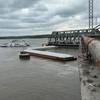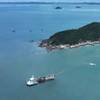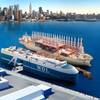After 39 years of service to NOAA and its predecessor agency, the
U.S. Coast and Geodetic Survey, the NOAA ship Whiting is being
decommissioned today in a ceremony at its home port in Norfolk, Va. The
ship has been an essential part of the NOAA fleet, working in support
of NOAA's mission to ensure safe navigation of the nation's coastal
waterways.
"It is a sad occasion to say goodbye to Whiting after so many years
of excellent service to the nation," said Rear Admiral Evelyn Fields,
director of the NOAA Commissioned Corps, the nation's seventh uniformed
service, and NOAA Marine and Aviation Operations, which operates and
manages the NOAA fleet of ships and aircraft. "After nearly 40 years,
it's time to replace it with a newer vessel that will operate more
efficiently. NOAA has already begun conducting surveys with its
replacement, the former Navy ship Littlehales, which is about one third
the age of Whiting and more cost effective to operate."
Mariners who use nautical charts to navigate coastal waterways
along the eastern seaboard can thank NOAA ship Whiting for providing
much of the hydrographic survey data used to create or update the
charts. Whiting boasted the most technologically advanced hydrographic
survey platform in the world. Outfitted with modern multibeam
echosounders and side-scan sonars, Whiting and its launches efficiently
and rapidly completed surveys for the safe navigation of the nation's
maritime commerce. The data storage for survey data was close to two
terabytes - one terabyte equaling 1,000 gigabytes. Nine workstations
allowed survey personnel to process the data with state-of-the-art
software and create impressive 3D models of the ocean floor, side scan
mosaics as well as imagery of historical wrecks like the USS Monitor.
In addition to conducting hydrographic surveys, she was used for
oceanography, fisheries research and homeland security surveys.
Whiting deployed last year to the Virgin Islands, Gulf of Mexico
and the southeast coast of the United States in support of homeland
security and nautical charting and returned in November. This deployment
marked an end to its 39 years of service. Commissioned in 1963, the ship
has successfully completed deployments from Duluth, Minn., to Honduras
and all waters in between.
Whiting has also played an important role in disaster response for
the nation. It was one of two NOAA ships that were instrumental in
finding the wreckage of John F. Kennedy's aircraft in 1999. That same
year, Whiting located the primary wreckage fields of downed Egypt Air
990 off the coast of Rhode Island.
Cmdr. Steven Barnum, NOAA Corps, has commanded Whiting for the past
two years. He also led the ground support of the ship during the Egypt
Air 990 recovery efforts. "Whiting has served the nation well not only
in the realm of nautical charting, but in helping to bring closure to
tragedies involving aircraft lost at sea. Her dedicated crew and
officers are sad to say farewell to Whiting, but are also looking
forward to continuing her important survey work aboard Littlehales."
Whiting is named for Henry Laurens Whiting, a 19th century engineer
who served in the U.S. Coast and Geodetic Survey. In addition to
becoming one of the great experts in topography and coastal engineering,
he served as an educator at the Massachusetts Institute of Technology
and the U.S. Naval Academy.
The NOAA fleet of research and survey ships and aircraft is
operated, managed, and maintained by NOAA's Office of Marine and
Aviation Operations. NMAO includes civilians and commissioned NOAA Corps
officers. The NOAA Corps is the nation's seventh and smallest uniformed
service and, as part of NOAA, is under the U.S. Department of Commerce.
The Corps is composed of officers - all scientists or engineers - who
provide NOAA with an important blend of operational, management and
technical skills that support the agency's environmental programs at
sea, in the air, and ashore.
Sponsored Content
Safer Starts Here: Build Ships, Protect Crews

Featured videos

Cat Pushes Forward on Hybrid Electric Solutions, Alternative Fuels

“One Man, One Wrench” Launched a Global Maritime Power Play

Corn Belt Ports Streamlines Critical Agriculture River Shipments
July 2025
 Read the Magazine
Read the Magazine

 Read the Magazine
Read the Magazine
This issue sponsored by:

The Golden Ticket – VIP access & invitation to take an active role in History
Subscribe for
Maritime Reporter E-News
Maritime Reporter E-News is the maritime industry's largest circulation and most authoritative ENews Service, delivered to your Email five times per week







